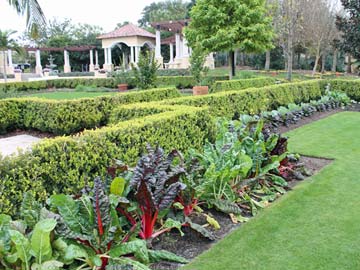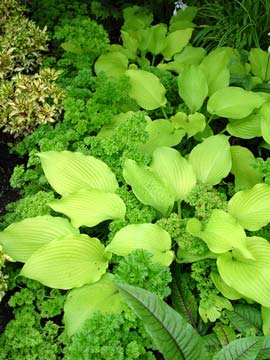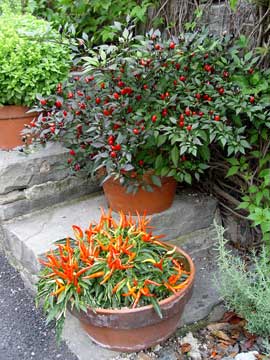Growing Edibles Without a Vegetable Garden
 Chard and cabbage are edibles used in an ornamental way in Hollis Gardens, a public garden in Lakeland, FL.
Chard and cabbage are edibles used in an ornamental way in Hollis Gardens, a public garden in Lakeland, FL.
© George Weigel
Somewhere down the path to modern American landscaping, home gardeners got the message that flowers are pretty and edible plants are not. The unspoken rules that followed that were: 1.) vegetables should go out back where they can be hidden, and 2.) no respectable gardener should ever mix “ugly” edibles with the landscape’s flowers and shrubs.
Edibles largely got pushed out of the landscape altogether as several generations wondered why they should sweat over growing their own food at all when they can just go to the grocery store and buy it. Now that fresh-grown vegetables – especially no-spray and heirloom ones – are making a comeback, gardeners also are questioning the idea of relegating them only to the far reaches. That’s been fueling the concept of “edible landscaping” or “foodscaping” – incorporating vegetables, herbs and fruits into beds throughout the yard as opposed to growing them only in a dedicated edible garden.
 Look at edibles for their ornamental traits and pair as you would with any other plant, such as contrasting the rounded form of this hosta with frilly-leafed parsley.
Look at edibles for their ornamental traits and pair as you would with any other plant, such as contrasting the rounded form of this hosta with frilly-leafed parsley.
© George Weigel
The truth is that many edible plants are colorful, attractive and ornamental in the landscape, even though they also happen to be edible. The ripening fruits and purple foliage of some hot peppers, for example, hold their own alongside geraniums or petunias in a flower garden. Golden oregano makes a durable, weed-choking and showy groundcover in even poor soil. Kale has both striking form and texture and is especially eye-grabbing in its purple-leafed form. And blueberry bushes offer the trilogy of spring flowers, brilliant fall foliage and bird attraction – unless you beat birds to the lunch.
A good way to break out of the edibles-in-the-back-only rule is to look at each plant for its ornamental value. Look at leaf color, texture, form, flower color and size. Based on those attributes, look for spots in the yard where a plant will look good, perform well and pair nicely with neighboring plants. In other words, the same design principles should apply whether a plant is edible or not. Drop the labels. You won’t violate any morals by planting frilly (and edible) parsley next to the rounded and color-coordinated leaves of a hosta or by adding red chard to a bed of red celosia.
 Hot peppers are colorful plants that can brighten a flower pot as well as any annual flower.
Hot peppers are colorful plants that can brighten a flower pot as well as any annual flower.
© George Weigel
Not sure you’re ready to go all out? Try tucking just a few of the most ornamental edibles into landscaping beds and see how you like it. Then add more or expand into other areas if things are working out. A bonus of colorful edibles is that most times, the most colorful varieties also happen to be the most nutritious. A second bonus is that many edibles are good at attracting beneficial pollinating insects, another current trend in gardening aimed at aiding dwindling pollinator populations. Since many edibles are annual plants that are removed after weeks or months when harvested, be ready to fill the space with something else. Eggplants, for example, can go into space vacated by spring onions, or a fall crop of lettuce can fill the space after purple cabbage is harvested.
A few other ideas on how to “sneak” edibles into the landscape:
- Use tall edibles with showy foliage (asparagus, rhubarb and kale, for example) as backdrops for shorter annual flowers.
- For small trees, consider dwarf apples instead of a crabapple, a native serviceberry tree instead of a non-edible redbud, or a fruiting cherry instead of a sterile flowering one.
- Instead of a hedge of forsythia or lilac, try a hedge of blueberries.
- For vines over an arbor, consider hardy kiwi or annual scarlet runner beans instead of flower-only species.
- Mix perennial herbs such as sage, chives and oregano into perennial-flower borders.
- And, use compact herbs, lettuce, hot peppers and other small plants in pots or window boxes alongside annual flowers and bulbs.
Some of the best edibles that also have good ornamental value:
Plants with colorful foliage or stems: chard, okra, golden oregano, kale, Malabar spinach, mesclun, mustard, purple basil, red lettuce, purple cabbage, sage, lemon or silver thyme.
Plants with colorful fruits or flowers: basil, beans, blueberries, bush cherry, calendula, cauliflower (especially purple or orange versions), chamomile, chives, currants, eggplant, grapes, hardy kiwi, lavender, melons, nasturtiums, okra, pansies, peas, peppers and hot peppers, radicchio, raspberries, strawberries, tomatoes and cherry tomatoes.
Plants with interesting texture or form: asparagus, bok choy, Brussels sprouts, cabbage, cardoon, carrots, celery, chard, chives, collards, coriander (a.k.a. cilantro), dill, fennel, garlic, garlic chives, globe artichokes, horehound, kale, kohlrabi, leeks, lemon grass, lettuce, lovage, mint (contain with in-ground barriers or grow in pots), okra, onions, parsley, rhubarb, rosemary, sage, spinach, sweet potatoes, tarragon.